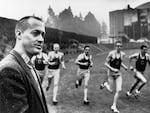
Bill Bowerman
Special Collections and University Archives, University of Oregon Libraries
"Victory is in having done your best. If you've done your best, you've won." — Bill Bowerman
Bill Bowerman (1911-1999) is considered one of the greatest track and field coaches the world has ever known. In his 24 years at the University of Oregon, he won four NCAA team championships and coached 33 Olympians, 16 sub-four-minute milers and 64 All-Americans.
But he was much more than a coach. Bowerman was a teacher in life. He called himself a professor of competitive response and imparted confidence and tenacity in his students — no matter what their level of talent — making each feel like a valued member of the team. He wanted them to take the principles of hard work and competition with them after graduation and apply those principles to their daily lives.
Bill Bowerman was an Oregon original steeped in pioneer stock. His ancestors traveled the Oregon Trail in 1845, first settling on the banks of the Tualatin River in the Willamette Valley. They later migrated to what is now Wheeler County and settled and named the town of Fossil for the petrified elephant and camel bones they found there. They opened and managed the settlement's first post office from their original homestead.
Bowerman's father, Jay, served as president of the Oregon Senate and, for a brief period, was acting governor of Oregon. His mother, Lizzie, graduated from Oregon Agricultural College (now Oregon State University) and was a teacher. After the couple divorced, Bill and his mother returned to Fossil where Bill spent his early years.
Rebellious as a child, Bowerman was kicked out of Medford High School for fighting. But after a humiliating lecture by the school superintendent, the young Bowerman turned his life around, becoming a star athlete and student. He married his high school sweetheart, Barbara Young, in 1936. They were partners in life for more than 60 years.
In 1934 Bowerman graduated from the University of Oregon with a bachelor's degree in business. While in college he played football and worked with legendary University of Oregon track coach Bill Hayward who, Bowerman says, taught him how to run. His newfound talent landed him on the University of Oregon track team.
With a keen interest in science, Bowerman had planned to be a doctor in college, but lacking money for medical school, he found his niche in coaching — teaching for a year at Portland's Franklin High School and then eight years at Medford High.
During World War II, Bowerman served as a major in the Army's 10th Mountain Division in Italy and returned to Medford a decorated hero. His alma mater recruited him back to Eugene when Bill Hayward retired, and in 1948 Bowerman joined the faculty as head track coach at the University of Oregon.
Bowerman built his coaching career around the belief that all athletes are individuals and all individuals learn differently. He developed weekly workout schedules tailored to each athlete's personal goals. Shunning overtraining, he pioneered the now well-known hard/easy method and believed in giving his runners easy days to let their bodies recover. It ran counter to what most coaches were preaching at the time, which was the more you put in, the more you get out.
A master of tactics and technique, Bowerman concentrated on helping each athlete reach their peak performance both physically and psychologically. He was always looking for the competitive edge and worked to improve running surfaces and equipment, experimented with recipes for sports drinks and even tailored lighter-weight uniforms.
He was also one of the first to experiment with moviemaking as a teaching tool. Using an old Army camera, he filmed his athletes in field events, then created film loops so they could study their technique — over and over again.
Obsessed with the weight of his athletes' equipment as an impediment to their performance, Bowerman focused his attention on creating a lighter-weight racing shoe. After taking lessons from the local shoemaker, Bowerman began cobbling custom-made shoes for his runners including half-miler Phil Knight, who was one of the first to wear them in the late 1950s.
In the early 1960s, Knight and Bowerman would team up again to co-found an athletic shoe distribution company, Blue Ribbon Sports, which would eventually become NIKE, Inc., the largest sports and fitness company in the world.
Always looking for better traction and cushioning, Bowerman's experiments with his wife's waffle iron and a little urethane resulted in the first lightweight waffle outsole. The waffle sole revolutionized the running shoe and helped put NIKE on the map.
His innovative ideas didn't stop on the track. Bowerman discovered "jogging" while on a trip to New Zealand in 1962. Back in Eugene, he started the first running clubs, which the local newspaper helped promote. When he and cardiologist Waldo Harris, M.D. wrote a book called "Jogging" in 1967, it helped propel the sport into a national pastime. Bowerman considered the research they did on the health benefits of running one of his greatest achievements.
Bowerman retired in 1972 after helping bring the first Olympic Trials to Eugene and coaching the U.S. Track and Field Team at the Munich Olympics. He continued to coach Olympic athletes, and he and Barbara were active in philanthropy, providing grants to athletic programs, schools and the arts.
Bill and Barbara Bowerman returned to Fossil in the late 1990s where Bill passed away in his sleep at the age of 88. His innovative Oregon spirit lives on at Hayward Field and in all those whose lives he touched.
Resources
Further Reading
A Biographical Study of William Jay Bowerman by William Hardin Freeman, 1972.
Bowerman and the Men of Oregon by Kenny Moore, 2006
Broadcast Date: February 12, 2007